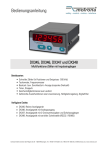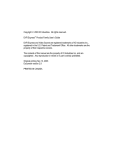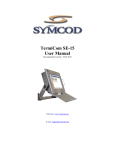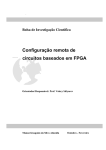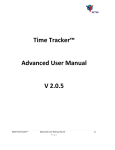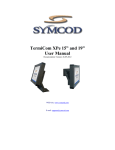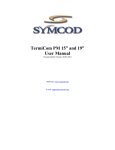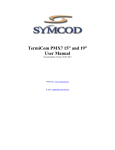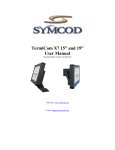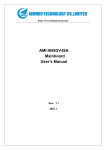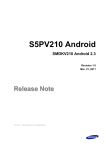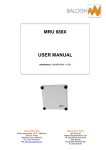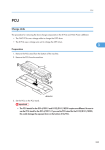Download DoorLock/IP V2 User Manual
Transcript
DoorLock/IP V2 User Manual Documentation Ver. 1.0A (14/12/2005) Our Web Site: http:// www.symcod.com/ Email : [email protected] DoorLock/IP V2 Warranty Symcod warrants its products to be free from defects in material and workmanship during one year from the purchase date. If a product proves to be defective in material or workmanship during the warranty period, Symcod will, at its choice, repair or replace the product with a similar product. Replacement Product or parts may include remanufactured or refurbished parts or components. The replacement unit will be covered by the balance of the time remaining on the customer's original limited warranty. Symcod provides no warranty for the thirdparty software included with the product or installed by the reseller, distributor, customer or any other party? Warranty does not include: Any product on which the serial number has been defaced, modified or removed. Damage, deterioration or malfunction resulting from: Accident, misuse, neglect, fire, water (except for waterproof units), lightning, or other acts of nature, unauthorized product modification, or failure to follow instructions supplied with the product. Repair or attempted repair by anyone not authorized by Symcod. Damage to or loss of any programs, data or removable storage media. Software or data loss occurring during repair or replacement. Any damage of the product due to installation of the product. Causes external to the product, such as electric power fluctuations or failure. Use of supplies or parts not meeting Symcod specifications. Failure of owner to perform periodic product maintenance as stated in documents supplied. Any other cause which does not relate to a product defect. Damage caused by static. Removal, installation, freight and set-up service charges. WWW.SYMCOD.COM Warning Safety and reliability, Page 3 Indoor use, Page 6 Powering, Page 6 Earth ground, Page 6 Fire safety and liability notice, Page 8 Tension, Page 15 Transient protector, Page 17 Disclaimer The material on this document* is intended for end user, distributor and/or reseller use. Although downloading and printing documents is allowed, Symcod will not be responsible for any modification or any other use of any content in the displayed/downloaded material. Please note that all documents* are subject to change without notice and are occasionally revised to specify, correct or revise the content or for other purposes. Therefore, the version displayed on the site may differ from your original printed copy. Please contact us if you require assistance. Symcod Inc. assumes no liability for damage incurred directly or indirectly, errors, omissions or discrepancies between the device and the manuals or documents supplied. Symcod is not responsible for any loss or damage (Including data corruption, interruption of operation, lost business information, lost production, etc.) caused by use, non-use or misuse of any of the information contained in this document*. Symcod Inc is not responsible of the content or validity of the links gave as references for other products not manufactured by Symcod Inc. *Documents include instruction book, user guide, operating instructions, manuals, safety precautions / instructions, data sheets or any other documents supplied by Symcod. 2 DoorLock/IP V2 WWW.SYMCOD.COM IMPORTANT Read me first By carrying out the installation and the use of this equipment you accept the rules and limitations described in this document or any other document relating to this product. By carrying out the installation and the use of this equipment you are presumed having read all the safety warnings ( ). WARNING : Safety and reliability SYMCOD Inc will not be responsible for the use of this equipment for other purpose then data collection. Symcod does not recommend the use of DoorLock/IP or any other equipment relating to access control as safety equipment. The Customer must have in place a safety systems appropriate to standard’s for his type of business. This equipment is designed and intended for an industrial and commercial use only. The DoorLock is not for a residential use. 3 DoorLock/IP V2 WWW.SYMCOD.COM Content Door-Lock V2 ................................................................................................................. 5 Main Characteristics ...................................................................................................... 5 Environmental specifications ...................................................................................... 6 Power................................................................................................................................. 6 Interfacing modes ........................................................................................................... 7 Wand emulation mode (barcode).................................................................................... 7 Biometric mode............................................................................................................... 7 Wiegand mode ................................................................................................................ 7 Installation example....................................................................................................... 8 Software command description .................................................................................. 9 Detailed Specifications ............................................................................................... 12 Connectors P1 et P2 : Barcode input .................................................................... 12 Connectors P1 and P2: Wiegand Input ................................................................ 13 Connectors P1 and P2: Logical Output ................................................................ 14 Connectors P3: Logical Input ................................................................................ 15 Connector P4 : Relay .............................................................................................. 16 Connectors DB01, DB02 : Serial ports RS-232 .................................................... 18 Ethernet Port........................................................................................................... 19 Power connector...................................................................................................... 20 DoorLock/IP configuration........................................................................................ 20 Compatibility (TCP port 1024).............................................................................. 20 Recommandations ........................................................................................................ 20 Accessories .................................................................................................................... 21 Dictionary....................................................................................................................... 22 Service and support ..................................................................................................... 22 Support..................................................................................................................... 22 Return Merchandise Authorisation (RMA) ......................................................... 22 4 DoorLock/IP V2 WWW.SYMCOD.COM Door-Lock V2 DoorLock is a device that is mostly used for access control. It allows the connection of 1 or 2 Bar Code, RFID (Wiegand) or biometric reader. The DoorLock has inputs and outputs that can be used in several ways. Amongst other things, the inputs can inform the administrator on the state of opening or closing of a door. The outputs can be used in association with a LED or a piezo to indicate the door status to the user. The communication with the computer is done with an Ethernet 10 BaseT connection. DoorLock must be configured according to your communication parameters with BoardConfig software. Main Characteristics 020-01349 Bio-Wand 020-01348 Bio-Weigand 020-01348F Bio-Weigand_F 1 1 1 2 2 2 2 2 2 2 2 2 1 1 1 3 3 3 1 1 1 3 3 3 1 1 1 260mA 260mA 260mA 1.8A 1.8A 1.8A Power supplied by DC injector (Symcod 1 or 16 ports) DoorLock power requirement Input power with or without peripheral DoorLock without peripheral Normally 3 inactive (Piezo) Logical outputs Normally inactive (DEL) Configurable dry contact mode or Voltage (5 to 16V) Dry contact Relay supplied Normally closed or open 2 Biometric RFID Wiegand 1 (with facility code) Barcode (Code 39) RS-232 2 DOOR LOCK MODEL Ethernet Product # Logical inputs Reader inputs RFID Wiegand 1 (without facility code) Comm. 650mA 650mA 650mA 1. The number of bits must be specified at the order. A 26Bits standard Wiegand card include: o a facility code from 0 to 255 o a card identifier 0 to 65535. At the order, Symcod can program the Wiegand decoder of the DoorLock so only the card identifier will be transmitted (order product # 020-01348). It is also possible to program the decoder according to your specifications if you use another type of Wiegand format (ex: 37 Wiegand bits). If you use the "facility code" and the card identifier, the transmitted code will be combined and will have to be converted by the software (Method provided by Symcod). 2. A serial port is used by the external biometric reader (biometric reader not included). 3. The piezo output is normally inactive, it is temporarily activated when a card is read, it is also possible to control it by software. 5 DoorLock/IP V2 WWW.SYMCOD.COM Humidity without condensation Door Lock /Bio-Wand X X X 0°C 40°C 85% Door Lock /Bio-Wiegand X X X 0°C 40°C 85% Door Lock /Bio-Wiegand F X X X 0°C 40°C 85% Minimum Temperature Maximum Temperature Environmental specifications Water Dust Exterior Interior Mobile Fix Product WARNING : indoor use only This equipment is intended for an interior use only. Power Product Description Door Lock Power for Bio-Wand Wand Mode up to Door Lock Bio-Wiegand Wiegand Mode Door Lock Bio-x Bio Mode X 504-00056 Power supply 12V, 2Amps. 1 X X 208-01001 Power supply 12V& single DC injector (POE)* 1 X X 022-01050 Power supply 12V& DC injector (max. 16 units)** 16 X X • Power by DC injector (single port or 16 ports) is possible if the overall power consumption while running do not exceed 650mA, including the external readers, DELs and piezo alarm. WARNING : powering Before installing, you must remove all power from every components (ex.: door strike…) including the DoorLock/IP. Only use the recommended power supply for the DoorLock/IP. Provide power to the unit only when the complete installation is done. WARNING : earth ground Make sure that all devices and casing are correctly grounded to a good Earth Ground. 6 DoorLock/IP V2 WWW.SYMCOD.COM Interfacing modes There are three interfacing modes for the connection of an external reader: wand emulation, biometric and Wiegand. Here is an example for each type. Wand emulation mode (barcode) DoorLock Wand/bio Slot reader SL-1003I Barcode reading Biometric mode DoorLock Wand/bio or Wiegand/bio Bioscrypt V-PASS Fingerprint reading Wiegand mode DoorLock Wiegand/bio Indala Proximity Reader Proximity Card/tag reading 7 DoorLock/IP V2 WWW.SYMCOD.COM Installation example 12VDC DoorLock Ethernet Door status indicator (Optional) External reader (Slot reader, proximity reader or biometric reader) Electric strike Door Warning : Fire safety and liability notice Never use access control equipment (card reader or others) for critical exits, entrance or exits doors, barriers, elevators or footbridges without providing an adequate alternative exit which is in accordance with all fire and life safety codes pertinent to the installation. The safety standards and requirements vary according to territories. See if your installation is in conformity with the regulation in force in your city or territory. Be sure to obtain an official written authorization concerning the matter of access control. Never accept verbal approvals, always ask for a written copy signed by an authorized person. 8 DoorLock/IP V2 WWW.SYMCOD.COM Software command description All commands can be sent through TCP or UDP protocol (port 1024) Compatibility (TCP port 1024) The DoorLock/IP support all commands from the following Symcod products: DoorLock V1, Bridge IP, LBC-02 VT-100/VT-52/SOH. Outputs 0 to 4, description Output # 0 1 2 3 4 Description Relay (Connector P4) Green LED (Connector P1& P2 pin #9) Yellow LED (Connector P1& P2 pin #3) Red LED (Connector P1& P2 pin #10) LED Piezo (Connector P1& P2 pin #4) Outputs x ON/OFF (TCP port 1024) Pxy x = Output number 0 to 4 y = E for OPEN, D for CLOSED or R for REQUEST LOGICAL INPUT # x STATUS Sequence example, open output #2: "P2E" * See section Connectors P1 and P2: Logical Outputs * See section Connectors P4: Relay Outputs x OPEN during XX second(s) or .X second (TCP port 1024) PxTyy x = Output number 0 to 4 yy = Opening delay (2 numbers) Sequence example, open output #2 for 4 seconds: "P2T04" Sequence example, open output #2 for 0.4 seconds: "P2T.4" * See section Connectors P1 and P2: Logical outputs * See section Connectors P4: Relay Logical Input 1,2,3 and 4 (TCP port 1024), description The LOGICAL INPUT # 1 and 2 return two possible states, ON or OFF If the logical input # 1 change for ON, the DoorLock will send the following characters: ASCII 242 If the logical input # 1 change for OFF, the DoorLock will send the following characters: ASCII 243 If the logical input # 2 change for ON, the DoorLock will send the following characters: ASCII 244 If the logical input # 2 change for OFF, the DoorLock will send the following characters: ASCII 245 If the logical input # 3 change for ON, the DoorLock will send the following characters: ASCII 246 If the logical input # 3 change for OFF, the DoorLock will send the following characters: ASCII 247 If the logical input # 4 change for ON, the DoorLock will send the following characters: ASCII 248 If the logical input # 4 change for OFF, the DoorLock will send the following characters: ASCII 249 * See section Connector P3: Logic input Received Barcode from input #1 or #2 (TCP port 1024) The DoorLock/IP has two Barcode inputs (Wand Emulation) • The input barcode #1 ends with ENTER (ASCII 13). • The input barcode #1 ends with $ ENTER ($ + ASCII 13). 9 DoorLock/IP V2 WWW.SYMCOD.COM Enable or disable the Batch mode (TCP port 1024) MC0:Mx x = Delay in seconds (1 to 9) that the PC have to read a Barcode. *Sets delay to 0 to disable the mode BATCH. Sequence example, enable the Batch mode with a 3 seconds delay: "MC0:M3" Sequence example, disable the Batch mode: "MC0:M0" Save a macro from 0 to 9 (TCP port 1024) MCx:Ry[Enter] x = Macro number, from 0 to 9 y = Macro string (to make a pause of 3 seconds add : ~3) [Enter] = ASCII 13 Sequence example, save macro # 0: "MC0:R P1DP2D P1T.1 ~1 P2T.2 ~1 P1E P2E ~2 P1D P2D" + Chr(13) Run a macro from 0 to 9 (TCP port 1024) MCx:P x = Macro number, from 0 to 9 Sequence example, run macro # 0: "MC0:P" Delete a macro from 0 to 9 (TCP port 1024) MCx:C x = Macro number, from 0 to9 Sequence example, delete macro # 0: "MC0:C" Requesting the content of a macro from 0 to 9 (TCP port 1024) MCx:L x = Macro number, from 0 to 9 The DoorLock/IP return: *x:y[Enter] x = Macro number, from 0 to 9 y = String that contain this macro [Enter] = ASCII 13 Sequence example, ask the content of macro # 0: "MC0:L" 10 DoorLock/IP V2 WWW.SYMCOD.COM Association : if event « y » then execute macro « x » (TCP port 1024) MCx:Ey x = Macro number 0 to 9 y = Event from 0 to 7 0 – Barcode reception input #1, no answer from PC, delay already passed 1 – Delay already passed, barcode reception input #1 2 - Barcode reception input #2, no answer from PC, delay already passed 3 - Delay already passed, barcode reception input #2 4 - Delay already passed, LOGICAL INPUT #1 changed for Press 5 - Delay already passed, LOGICAL INPUT #1 changed for Release 6 - Delay already passed, LOGICAL INPUT #2 changed for Press 7 - Delay already passed, LOGICAL INPUT #2 changed for Release Sequence example, association, event #0 is associated to macro # 2: "MC2:E0" * A Macro number can be associated to several different events. * The events work only if the mode BATCH is activated. Delete event association (TCP port 1024) MCy:D y = Event from 0 to 7 Sequence example, delete event association #0: "MC0:D" Ask the mode and associations (TCP port 1024) MC0:? The DoorLock/IP return: xy,z[Enter] x = Batch for “MODE BATCH” or RealT for “MODE REALTIME ONLY” y = Delay in second (1 to 9) that the PC as to answer a Barcode z = Associated macro for each event (- = aucune association) [Enter] = ASCII 13 Sequence example, ask mode and associations: "MC0:?" The return value z will be 10 characters long, but only the first 8 characters will be used (event from 0 to 7). 11 DoorLock/IP V2 WWW.SYMCOD.COM Detailed Specifications Connectors P1 et P2 : Barcode input Figure 1 5 Volts Barcode data Earth Ground Ground (Gnd) Barcode pinout on connectors P1 & P2 The barcode inputs (see figure 1) are designed to accept wand type barcode (Wand emulation). Any device like a slot reader, a wand scanner or a laser can be connected to the port as long as it is in « wand emulation ». Both input use the same internal decoder but the DoorLock/IP use an identification and discrimination system that can determine the origin of the barcode. Identifier: Discriminator: Input barcode 1 transmits the integral code. Input barcode 2 add the $ sign before the code to identify the origin. If 2 cards are swipe simultaneously, the discriminator will only consider the first card. DoorLock internal picture JP2 and JP3 location To use the input in barcode mode, jumpers JP2 and JP3 must be in position 1-2 (WAND). The input will provide a 5V 250mA tension on both P1 and P2 connectors, which is usually enough for any « wand emulation » devices. 12 DoorLock/IP V2 WWW.SYMCOD.COM Connectors P1 and P2: Wiegand Input Figure 2 12 Volts Data 0 Wiegand Data 1 Wiegand Ground (Gnd) Earth Ground Wiegand pin out on P1 and P2 connectors The Wiegand inputs (see figure 2) are designed to accept proximity reader. Both input use the same internal decoder but the DoorLock/IP use an identification and discrimination system that can determine the origin of the reading. Identifier: Discriminator: Input Wiegand 1 transmits the integral code. Input Wiegand 2 add the $ sign before the code to identify the origin. If 2 cards are swipe simultaneously, the discriminator will only consider the first card. DoorLock internal picture JP2 and JP3 location To use the input in Wiegand mode, jumpers JP2 and JP3 must be in position 2-3 (WIEGAND) and the DoorLock/IP must be ordered Wiegand/Bio. You also must specified when you order if you need special encryption type (ex: 37 bits Wiegand) otherwise you will get the unit in standard Wiegand 26 bits. The input will provide a 12V 250mA tension on both P1 and P2 connectors, which is usually enough for any Wiegand type devices. The 12 VDC output is not regulated, so the output tension is equal to the one on the DoorLock/IP input power. 13 DoorLock/IP V2 WWW.SYMCOD.COM Connectors P1 and P2: Logical Output Figure 3 Output #3 (Red) Output #1 (Green) Output #2 (Yellow) Output #4 (Piezo) Logical output pin out of connectors P1 and P2 All logical outputs are open collector type and are remote controllable by software. The four outputs are available on both connectors P1 and P2, they are connected in parallel so each one will display the same state simultaneously. Three of these outputs are specially made for LEDs (red, yellow and green) and they are normally opened (OFF). The last output is made for a piezo alarm and is normally opened (OFF) and closed (ON) momentarily when a good read occur on reading a card. Figure 4 How to use the connectors P1, P2 and P3 1. 2. 3. Insert a small flat screwdriver in the opening (square) of the corresponding wire. Insert the wire into the round opening. Remove the screwdriver and pull lightly the wire to make sure that it is properly attach. 14 DoorLock/IP V2 WWW.SYMCOD.COM Connectors P3: Logical Input Figure 5 Input #4 Anode 12 Volts Ground (Gnd) Input #4 Cathode Dry contact input #3 Dry contact input #2 Dry contact input #1 Ground (Gnd) Logical input pinout of connector P3 TTLIN4 TTLIN4 TTLIN3 TTLIN3 TTLIN2 TTLIN1 TTLIN2 TTLIN1 16 U7 1 15 2 14 3 13 4 12 5 11 6 10 7 9 8 1 R6 1K 2 2 R7 1K 1 2 R8 1K 1 1 R9 1K 2 IN+4 IN-4 IN-3 IN-4 1 2 3 4 5 P3 1 2 3 4 5 6 7 8 9 10 6 7 8 9 10 12V_OUT IN-1 IN-2 IN-3 IN+4 F9 250mA IN-2 IN-1 LTV-846 Internal circuit of the logical input The P3 connector (see figure 5) of the DoorLock/IP as 4 logical inputs, the inputs 1,2 and 3 are designed to receive dry contact type signal (switch, captor…), input 4 is configurable in either a dry contact type or voltage type (5-16 VDC). For the voltage type, it is possible to have a 16 to 32 VDC input by adding a ) in serial with the positive signal (anode) of pin 10. To configure input 1Kohms resistor (see following 4 into dry contact type you must install a jumper between the pin 9 and 10 of the P3 connector and connect the dry contact between pin 4 and pin 5 of the P3 connector. The 4 logical inputs on the DoorLock/IP allow a maximum of 5 pulses per second. Warning : Tension A tension higher than 16Vdc doubled with a missing serial resistor will destroy the input voltage of input 4. 15 DoorLock/IP V2 WWW.SYMCOD.COM Connector P4 : Relay Figure 6 Pin out of connector P4: P4 Connector 1- Relay power input, DC Positive /AC live 2- Relay power input, DC Ground /AC Neutral 3- Relay common output, DC Ground /AC Neutral 4- Relay output Normally close, DC Positive /AC live 5- Relay output Normally open, DC Positive /AC live F2 3.5A K1 6 3 8 1 5 1 2 3 4 5 1 2 3 4 5 P4 4 G6C-2114P-US-DC12 Internal circuit Pin out for P4 connector The output relay (connector P4, figure 6) offers a dry contact either normally close or normally open protected by a 3.5 Amp. fuse (see transient protector warning ). The relay allows the activation or deactivation of a door strike or a door magnet but it does not provide power to either the door strike nor to the door magnet. The input voltage should never exceed 32 volts AC or DC. 16 DoorLock/IP V2 WWW.SYMCOD.COM WARNING : Transient protector DC Electric strike, connection example DC Electric strike P4 Connector Power Supply Max. 32V DC Transient protecteur 1N4001 CA Electric strike, connection example CA Electric strike P4 Connecteur Power Supply Max. 32V CC Transient protector MOV 47 Volts ERZ-V07D470 DC electromagnet, connection example CA electromagnet, connection example DC Électromagnet CC Electromagnet P4 Connector Transient protector 1N4001 Power Supply Max. 32V DC Connecteur P4 Bloc D’alimentation CC 32V Max. Transient protector MOV 47 Volts ERZ-V07D470 Always use the proper contact protector for your electrical strike or door magnet. A 1N4007 diode for door strikes or door magnet using DC, and a 47 Volts varistor for AC, are provided with the DoorLock/IP. The transient protector should be installed at a maximum of 12inch/30cm distance from the door strike or door magnet. In case that you omit to install the transient protector an inductive tension up to 500 volts can be generated when the door strike or the door magnet or else is turned off. This tension may wear out prematurely the contacts. Also, it can cause unwanted electromagnetic interference. The life of the relay will be dramatically reduced. With the transient protector the life of the relay could exceed 50 millions activations. 17 DoorLock/IP V2 WWW.SYMCOD.COM Connectors DB01, DB02 : Serial ports RS-232 Figure 7 2- Receive RS-232 3- Transmit RS-232 5- Ground (Gnd) 4-6 Internal jumpers 7-8 Internal jumpers 9- Output power 5V or 12V Pin out connectors DB01, DB02 DoorLock/IP internal Jumper JP1 The serial RS-232 connectors (figure 7) can be use to connect almost any serial RS-232 devices. On the ). DoorLock/IP they allows to connect and also power the biometric readers (see following Two TCP connections can be established through the port 1034 for connector DB01 and port 1044 for connector DB02. The DoorLock/IP transparently redirect all characters sent to the TCP link to the RS-232 and from the RS-232 to the TCP link. Both serial ports have the same configuration (Bauds, Parity, Data Bits…) define with the BoardConfig software (provided free of charge by Symcod). Only data signal on pin 2 and 3 are managed, there is no hardware handshaking available. It is possible to power up an external device through pin 9 of the DB-9 (ex. Biometric reader). Jumper JP1 allows you to choose from either 5VDC (regulated) or 12 VDC (pass through) for both port DB01 and DB02 simultaneously. Maximum current for each port is 650mAh. In the 12VDC case, since it is a pass through, the current is equal to the power input of the DoorLock/IP. To power a peripheral through the Ethernet cable, the total current of the peripheral combined with the current draw by the DoorLock/IP cannot exceed 650mAh. In the case of the Biometric reader you MUST use the individual power supply you cannot use the DC Injector. * See sections: Main Characteristics / current 18 DoorLock/IP V2 WWW.SYMCOD.COM Ethernet Port Figure 8 Ethernet activity LED (yellow) Input (Gnd) DC injector RX- Ethernet Input 12 V DC injector Ethernet Link active (Green) TX+ Ethernet TX- Ethernet RX+ Ethernet Ethernet port pin out The DoorLock/IP communicate through an Ethernet 10 BASET network (figure 8). The connector is a standard type RJ-45 connector. The connector as 2 LED’s, the green one showing the active link with the network and the yellow one that shows the activity. The DoorLock/IP can be powered by an individual power supply, a single or 16 ports DC-Injector (use only SYMCOD DC-Injector). As all the standard 10BaseT Ethernet devices, it uses a UTP CAT5 cable. A maximum length of 300 feet (91.44 meters) is allowed between the HUB or the SWITCH and the DoorLock/IP. For more information on cabling issue, please download « Ethernet wiring and recommendations TCPIP v.31-03-2005 » available free of charge on our website at WWW.SYMCOD.COM. 19 DoorLock/IP V2 WWW.SYMCOD.COM Power connector Figure 9 Power connector polarity The power connector (figure 9) allows you to provide power to the DoorLock/IP with an individual power supply. The input is 12VDC with protected polarity and overcharge at 1.8Amps maximum. The connector is a Switch craft type 712RAPC, and accept 2.5mm plug, center positive. DoorLock/IP configuration The DoorLock/IP is configurable with the BoardConfig software, that is free of charge (free registration needed) and can be downloaded from our website at www.symcod.com. Download section. A sample software written in Visual Basic 6 is also available with source code. Compatibility (TCP port 1024) The DoorLock/IP support commands of these other product: • DoorLock V1 • Bridge IP • LBC-02 mode VT-100, VT-52 or SOH. Recommandations Ethernet Cabling: Please consult “Ethernet wiring and recommendations TCPIP v.31-03-2005” available on our website at www.symcod.com before proceeding with your installation. DoorLock/IP Accessibility: For security reason it would be preferable to install the DoorLock/IP where only administrator can have access. 20 DoorLock/IP V2 WWW.SYMCOD.COM Accessories # Product Description Picture 504-00056 Individual Power Supply 12 VDC 25W 518-00792 P3 connector cover Optional, protect the wire on the DoorLock/IP 518-00793 P1, P2 connector cover Optional, protect the wire on the DoorLock/IP 023-01070 DoorLock/IP junction box to Wand emulation (include 61000271) Sealed box 4½" X 2¾" X 2" with LED green/yellow/red. Allow visual display of the door status (open/close) Circuit jonction DoorLock to wand emulation 610-00271 Electronic circuit ONLY with LED green/yellow/red Allow visual display of the door status (open/close) 016-01001 Sealed Slot reader SL-1003I (vandal resistant) wand emula. Cable with uninstalled DB-9F connector 016-01002 Sealed Slot reader SL-1003I (vandal resistant) wand emula. Cable with soldered DB-9F connector BioScrypt V-PASS Kit 206-01451 DoorLock to BioScrypt cable included (DoorLock not included) 528-87400 Indala Proximity reader (type Wave blue) 26 bits Wiegand standard 21 DoorLock/IP V2 WWW.SYMCOD.COM Dictionary RFID Radio Frequency Identification, uses radio frequency to transmit data Barcode Optical translation, uses alternate bars and spaces into numerical data allowing identification of an entity. Biometric Identifies user with physiological characteristics of it’s own (fingerprint, geometrical forms, iris…) Proximity POE Symcod LED Uses RFID to transmit unique code wirelessly Power Over Ethernet uses the Ethernet cable to provide power. Proprietary to Symcod. Light Emitting Diode, electronic component that lights up when electrical current is apply to it. A type of speaker driver that creates sound when a quartz crystal receives electrical energy An electro mechanical device used to unlock a door from a remote location Piezo Door Strike Relay An electrically controlled mechanical device that opens and closes electrical contacts when a voltage (or current) is applied to a coil Logical Input Logical Output Jumper Compatibility Verify the state of a switch (ex: open/close) Allow activation of a peripheral (ex: LED, piezo) Small, removable plastic cap on connector pins that acts as a switch. Designed to work with another device or system without modification Service and support Support Please use the EMAIL for your requests. For technical questions (hardware and software), email at [email protected] • Provide a detail description of the problem and/or questions (intermittent problem, happens when…) • Please indicate model number and serial number (if applicable). For all other questions, please use [email protected] or Symcod Inc. at 1171 Notre-Dame O., Victoriaville, Qc, G6P 7L1 Phone: 1-800-203-9421, 1-819-751-0095 Fax: 819-751-1292 Return Merchandise Authorisation (RMA) All return request must be authorized by SYMCOD Inc.. To do so please refer to the following: http://www.symcod.com/rma • You will receive a formal confirmation number (# RMA) • The RMA number must be printed on each box. • All freight charges are at the customer expense and responsibility. Please take note that “collect” package will be refused. 22






















